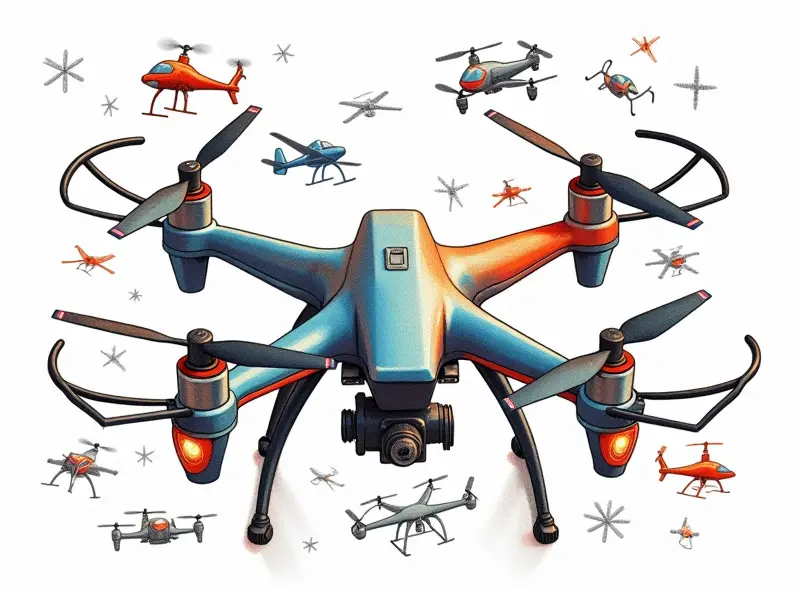What is Li-Po for drones?

Why LiPo Batteries Rule Drone Tech
Lithium Polymer (LiPo) batteries are the gold standard in drone technology, offering unmatched performance and efficiency. These rechargeable batteries provide high energy density, meaning they can deliver a lot of power without adding much weight to your drone. This makes them ideal for applications where every gram counts, such as racing drones or long-range surveillance operations.
LiPo batteries are also known for their ability to discharge large amounts of current quickly, which is crucial for the high-performance demands of modern drones. Additionally, they have a relatively flat voltage curve during discharge, ensuring consistent power delivery throughout each flight session.
Understanding LiPo Batteries in Drones
Lithium Polymer batteries are composed of multiple cells connected in series or parallel to achieve the desired voltage and capacity for your drone. Each cell typically has a nominal voltage of 3.7V, but they can be charged up to 4.2V per cell.
The number of cells determines the battery's overall voltage (e.g., a 3S LiPo battery has three cells in series and provides around 11.1V). The capacity is measured in milliampere-hours (mAh), indicating how much energy the battery can store. For example, a 5000 mAh battery can theoretically provide 5A of current for one hour.
Maximize Flight Time with LiPo Batteries
To extend your drone's flight time, it’s essential to choose a LiPo battery with the right capacity. Higher-capacity batteries will allow you to fly longer but may add more weight to your drone. Balancing these factors is key.
- Higher Capacity: Opt for higher mAh ratings if extended flight time is crucial, especially for surveillance or aerial photography drones.
- Battery Weight: Consider the trade-off between battery weight and capacity. A lighter battery might not last as long but can improve your drone's overall performance.
Choosing the Right LiPo Battery for Your Drone
Selecting the right LiPo battery involves understanding your drone’s power requirements:
- Demand Analysis: Assess how much current your drone needs to operate efficiently. This will help you choose a battery with sufficient discharge rates.
- Battery C-Rating: The C-rate indicates the maximum continuous discharge rate of the battery. Higher C-ratings are necessary for high-performance drones like racing models, while lower ratings suffice for casual use or long-range flights.
How LiPo Batteries Power FPV Racing Drones
FPV (First Person View) racing drones require batteries that can handle extreme power demands. High C-rating and high discharge rates are crucial to maintain speed and responsiveness during races:
- C-Rating: Choose a battery with a high C-rate, typically 40C or higher for FPV racing.
- Discharge Rates: Ensure the battery can handle rapid discharge rates to keep up with the fast-paced nature of racing drones.
The Benefits of Using LiPo Batteries in RC Helis
Lithium Polymer batteries offer several advantages for remote-controlled helicopters:
- Lightweight Design: The low weight-to-energy ratio allows RC helis to achieve better lift and maneuverability.
- Fuel Efficiency: LiPo batteries provide consistent power delivery, enhancing the overall performance of your helicopter.
LiPo Battery Safety Tips for Quadcopter Pilots
Safety is paramount when working with LiPo batteries. Follow these guidelines to prevent accidents and extend battery life:
- Proper Storage: Store your batteries in a fireproof container, away from flammable materials.
- Battery Monitoring: Use a charger that monitors voltage and current during charging to avoid overcharging or undercharging.
LiPo Battery Basics for FPV Racing
To excel in FPV racing, it’s essential to understand the basics of LiPo batteries:
- Battery Capacity: Opt for a battery with sufficient capacity to support extended flight times.
- Voltage and C-Rating: Ensure your battery has the right voltage and high C-rating to handle rapid discharge rates.
How LiPo Batteries Work in RC Quadcopters
Lithium Polymer batteries power quadcopters by providing a steady flow of electricity. The cells are arranged in series or parallel configurations to achieve the desired voltage and capacity:
- Voltage Configuration: Series configuration increases battery voltage, while parallel configuration boosts capacity.
- Battery Management System (BMS): A BMS monitors each cell’s voltage, ensuring balanced charging and discharging for optimal performance.
Maintaining LiPo Batteries for Optimal Performance
To keep your LiPo batteries in top condition:
- Battery Balancing: Use a charger with balancing capabilities to ensure each cell is charged evenly.
- Cycle Management: Avoid deep discharges and limit the number of charge cycles for longer battery life.
The Role of LiPo Batteries in FPV Racing
In FPV racing, LiPo batteries are critical components that influence performance and safety. High-quality batteries with appropriate C-ratings ensure your drone can handle rapid discharge rates during races:
- Performance Enhancement: Choose a battery that matches the power requirements of your racing drone.
- Safety First: Follow proper handling and storage procedures to prevent accidents.
Conclusion
Lithium Polymer batteries are indispensable in modern drone technology, offering superior performance, efficiency, and versatility. Whether you're flying FPV racing drones or RC helis, understanding the nuances of LiPo battery selection and maintenance is crucial for optimal operation. By adhering to safety guidelines and choosing the right batteries, you can maximize your drone's capabilities while ensuring long-term reliability.

